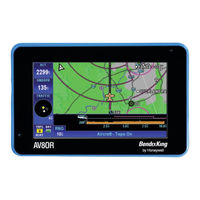BENDIXKing AV80R Manuals
Manuals and User Guides for BENDIXKing AV80R. We have 2 BENDIXKing AV80R manuals available for free PDF download: User Manual
BENDIXKing AV80R User Manual (368 pages)
BendixKing AV80R Handheld GPS User’s Guide
Brand: BENDIXKing
|
Category: GPS
|
Size: 5 MB
Table of Contents
-
-
Fast Access52
-
Data Fields58
-
Change View69
-
Airports71
-
Rnwys Tab72
-
-
Autonav100
-
-
DATA VIEW Mode118
-
Edit Fplan118
-
MAP VIEW Mode119
-
New Fplan120
-
Invert Fplan120
-
Delete Fplan121
-
Flight Logging124
-
Weather Function126
-
-
Legend154
-
XM Overlays155
-
Traffic Function160
-
Chart View Page165
-
Panel Function168
-
-
Messages Page170
-
Checklist173
-
-
Data Entry177
-
C.G. Graph179
-
Layout180
-
Profile180
-
Envelope182
-
-
-
Refresh Mode207
-
Shut down211
-
-
-
Map Updates214
-
-
Glossary214
-
Getting Started216
-
-
Using the Map225
-
-
Smart Zoom236
-
Position Markers237
-
Itinerary240
-
Track Logs242
-
Managing POI244
-
Saving POI244
-
Camera Types245
-
Camera Warning245
-
ROUTE Navigation250
-
-
Using Track Logs273
-
Map Screen277
-
Icons on the Map281
-
-
Cursor Menu289
-
Detour Menu289
-
Position Menu292
-
Quick Menu301
-
GPS Data Screen303
-
Find Menu306
-
Route Menu307
-
Manage Menu309
-
Manage History310
-
Manage Favorites312
-
Manage Pois312
-
Settings Menu316
-
Sound Settings319
-
Warning Settings326
-
GPS Settings328
-
Menu Settings328
-
Device Settings329
-
-
4 Multimedia
331-
Music Player331
-
Photos332
-
Movie Player333
-
Ebook Reader335
-
GPS Status339
-
Volume340
-
System Info341
-
Bluetooth342
-
Initial Setup347
-
Advertisement
BENDIXKing AV80R User Manual (273 pages)
Handheld
Brand: BENDIXKing
|
Category: GPS
|
Size: 4 MB
Table of Contents
-
-
Using AV8OR30
-
Main Menu32
-
-
-
-
Demo Mode40
-
-
-
-
Data Fields50
-
-
-
Map Zooming57
-
Map View57
-
Smartprofile58
-
Ptr Menu72
-
Center Map76
-
Autonav78
-
Stop Watch79
-
-
-
Edit Fplan89
-
Fplan Admin91
-
User Wpts93
-
Fly Fplan95
-
Legend101
-
-
Map Setup111
-
Navigation Setup114
-
Data Field Setup118
-
Demo Mode Setup121
-
Device Setup123
-
Status Page125
-
Shut down127
-
-
-
Glossary130
-
Getting Started132
-
-
Smart Zoom151
-
Position Markers152
-
Itinerary155
-
Track Logs157
-
-
Managing POI158
-
Saving POI158
-
Camera Types159
-
Camera Warning159
-
ROUTE Navigation162
-
-
-
Map Screen190
-
Icons on the Map194
-
Detour Menu201
-
Cursor Menu202
-
Position Menu205
-
Quick Menu213
-
Gps Data Screen216
-
Find Menu219
-
Route Menu220
-
Manage History223
-
Manage Favorites224
-
Manage Pois225
-
Settings Menu228
-
Sound Settings231
-
Warning Settings238
-
Gps Settings240
-
Device Settings241
-
Menu Settings241
-
Multimedia245
-
Music Player245
-
Photos246
-
Movie Player248
-
Ebook Reader249
-
-
-
GPS Status251
-
Backlight251
-
Volume252
-
System Info253
-
Bluetooth254
-

